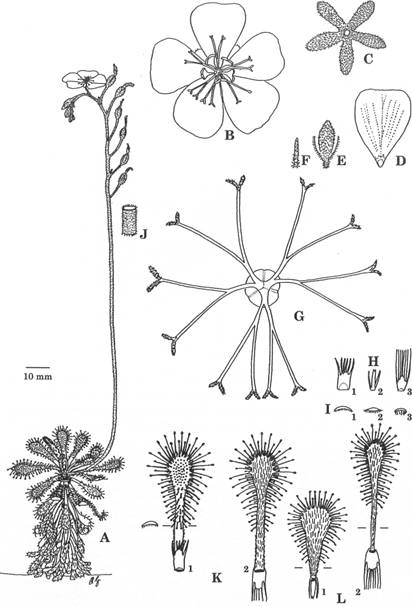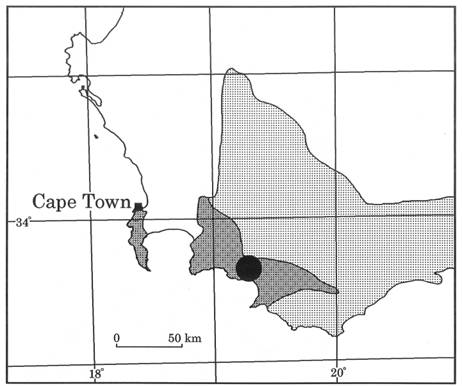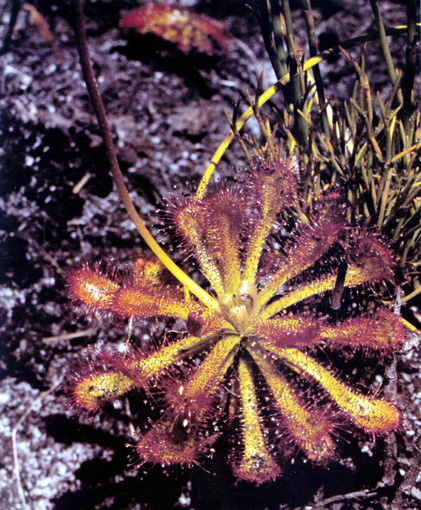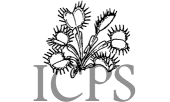|
Carnivorous Plant Newsletter
Volume 28, Number 3, September 1999, pages 81-84; Front Cover
DROSERA X CORINTHIACA (DROSERACEAE),
A NEWLY RECOGNISED
NATURAL HYBRID FROM
THE CAPE PROVINCE, SOUTH AFRICA
ROBERT GIBSON • New South Wales • Australia
ERIC GREEN • Cape • Republic of South Africa
Keywords: new taxa: Drosera x corinthiaca, South Africa.
Received: 21 October 1998
Abstract
Drosera x corinthiaca Gibson and Green, the natural hybrid between Drosera aliciae Hamet and D. glabripes (Harvey) Stein is described, illustrated and named. It occurs in the Cape Province of South Africa.
Introduction
Drosera x corinthiaca hybr. nov. is known from the type location in the Kleinriviersberg mountains, where it was initially recognised by one of us (E.G.) as a hybrid. It is likely to also occur in the Kogelberg where both parental species grow in close proximity. Its natural range is thus highly localised but protected in nature reserves. It resembles a short-stemmed form of Drosera glabripes with a relatively tall scape and flowers with twice-bifurcated styles. The latter characteristics are inherited from Drosera aliciae.
Taxonomy
Drosera x corinthiaca Gibson & Green, hybrida nova D. aliciae Hamet x D. glabripes (Hav.) Stein
Caulis 2-15 cm longus. Folia spiraliter disposita, stipulis 5-7mm longis, trilobis, lobis lateralibus subulatis, lobo medio diviso in lobulos 4 subulatos; petiolo 15-18mm longo, supra fere glabro subtus piloso, lamina 15-25mm x 3-5mm, obovata, supra et margine glanduloso-pilosa, subtus pilosa. Scapus 1, prope caulis apicem lateraliter oriens, 15-20cm longus, e basi paullo curvatus adsendenti-erectus, basin versus nonnunquam sparse pilosus praecipue apicem versus minute glandulosus. Inflorescentia 8-13-flora, bracteis 4mm subulatis glandulosis, pedicellis 7-9mm longis glandulosis. Sepala 5, 4-5mm x 2-3mm, basi connata, elliptica, glandulosa. Petala 5, 10-11mm x 7-8mm, obovata, rosea. Stamina 5, filamentis 2-3mm longis. Ovarium 1.2 x 1.4mm globosum glabrum, stylis 3, 5mm longis, basi bipartitis, segmentibus omnibus stylorum iterum bifurcatis. Semina fusiformia.
Typus: Fernkloof Nature Reserve, middle western slopes of Platberg overlooking Hemel-en-Aarde. 500 metres. Grid Ref: 3419AD - Caledon, Cape Province, Republic of South Africa. December 12, 1997, R. Gibson 1001 (holo: NBG 759 343).
Perennial herb; stem erect, up to 150mm tall with age, c. 2mm diameter, with a terminal active solitary leafy rosette, the leaves below the rosette persistent. Leaves spathulate, up to 25mm long by 5mm wide; the blade obovate (6-)8-9 x 4-5mm on a straight-sided petiole 15-18mm x 3-4mm, abaxial surface fully covered by white appressed hairs, petiole margin often weakly recurved. The adaxial surface of the lamina and adjoining half of the petiole glandular hairy. Stipules white, free, c. 7 x 4mm, divided half to the base into 3 unequal lobes, those on the margin subulate, that in the middle broadly triangular and further divided three-quarters of the way to the base into 4 equal subulate lobes. Inflorescence ascending, 150-200 x 1.5mm with a moderate density of scattered red, very short stalked glands along its length and extending to the pedicels, bracts, and calyx; the basal 8-10mm with scattered white hairs similar to those on the abaxial leaf surface. Bracts subulate, to 4mm long. Pedicels 7-9mm long. Sepals 5, elliptic 5 x 2mm. Petals 5, dark pink, obovate, free end truncate, 10-11 x 7-8mm. Stamens 5, the filaments white, 2-3mm, the connective swollen. Anthers paired, yellow. Ovary green, glabrous, obovoid c. 1.2mm tall, c. 1.4mm diameter at anthesis, carpels 3. Styles 3, horizontal, bipartite, cerise, 5mm long, each segment divided again by two thirds into 12 ultimate style segments. The stigma lobes once bifurcated, oblong, with bristles. Probably sterile. (Figure 1).
Drosera x corinthiaca differs from Drosera aliciae (whose features are given in parentheses) by the formation of a stem at maturity (rosette is flat and at ground level, or at most on a very short pedestal); 1mm internodes between the leaves (no internodes); stipule with three primary lobes in which the central broadly triangular lobe is subdivided into 4 subulate lobes (central stipule lobe is broadly triangular, with an entire or bifurcated tip); and leaf spathulate with the petiole margin often weakly recurved (leaf obcuneate to broadly spathulate, bi-convex in section).
Drosera x corinthiaca differs from Drosera glabripes (whose key features are given in parentheses) by 1mm internodes (>2mm internodes); stipule deeply incised into three primary, unequal lobes, the lateral ones subulate and the central broadly triangular one is deeply subdivided into 4 subulate lobes (stipule weakly divided into three unequal lobes, the lateral ones subulate and the central broadly triangular one is deeply divided into 6 subulate lobes; leaf spathulate, with petiole margin often weakly recurved (leaf narrowly spathulate, petiole margin moderately recurved); scape over 150mm tall (scape under 150mm tall); style segments twice bipartite (style segments once bipartite).
This natural hybrid superficially resembles a short form of Drosera glabripes, with close-spaced wider leaves. The taller scape and more divided style segments are more typical of Drosera aliciae (see Front Cover below).
Distribution and Habitat: Drosera x corinthiaca is known only from the Kleinriviersberg (Figure 2). However, given its origin as a sterile natural hybrid, it is likely to occur in other locations where both parental species grow in close proximity, such as the Kogelberg. It grows in permanently moist peaty sandy soil on the edges of swamps and small creeks, often amongst D. aliciae.
Flowering Period: December to January.
Conservation Status: Drosera x corinthiaca is only known from the type location where it is locally common, and where both parental species grow within 20 metres from each other. It is also likely to occur in other areas of the Kleinriviersberg and the nearby Kogelberg where similar geomorphological conditions occur. Although the maximum potential range of this hybrid is not large the main habitats are within nature reserves.
Etymology: The epithet, corinthiaca, from the Greek Korinthos, refers to the Corinthian column-like appearance of the mature plant.

Figure 1: Drosera x corinthiaca A - mature plant x 1; B - open flower x 3; C - calyx x 3; D - petal x 3; E - sepal x 3; F - bract x 3; G - gynoecium x 10; H - stipules x 2, 1=D. x corinthiaca, 2=D. aliciae, 3=D. glabripes; I - petiole sections x 2, 1=D. x corinthiaca, 2=D. aliciae, 3=D. glabripes; J - scape cross section x 3; K - D. x corinthiaca leaf x 2, 1=adaxial surface, 2=abaxial surface; L - abaxial leaf surface x 2, 1=D. aliciae, 2=D. glabripes. Drawing from Gibson 1001. The stipules (H:2,3), leaf cross-sections (1:2,3), and abaxial surfaces (L:1,2) of the parental species are shown for comparison. Bars on leaf sections (K:1, L:1,2) indicate locations of leaf cross sections. Scale bar = 10mm at 1 x.

Figure 2: Distribution map of Drosera x corinthiaca. The type location is marked by a dot. The western range of Drosera aliciae, the probable seed parent, is indicated by dots, and the range of Drosera glabripes, the probable pollen parent, is indicated by light grey. This hybrid may occur spontaneously wherever both species grow in close proximity.
Discussion: This hybrid is probably sterile, given field relations of this hybrid to its probable parent, and from the study of other hybrids within the genus (Cheek, 1993). It is likely that this hybrid may reproduce asexually from the sparse, moderately swollen rootstock, especially after the above-ground growth has been cleared by not infrequent fynbos fires. Before the time of collection only two juvenile plants were known, but a nearby colony with many mature plants was found. This enabled the tentative identification of the parentage to be confirmed, especially as they grew amongst D. aliciae (the seed parent) in soils too damp and peaty for D. glabripes (the pollen parent), which grew amongst rocks and in well-drained sandy soil on the adjacent hill slope. Occasionally rosettes of D. x corinthiaca become bright yellow in colour; similarly the only other locally known Drosera hybrid (D. aliciae x D. capensis), may become very pale green.
Acknowledgments
The assistance and support of Dr. John Rourke and the other friendly staff at the Compton Herbarium, Cape Town is gratefully acknowledged. I also wish to thank Dr. Jan Schlauer for his assistance with the Latin description.
Reference
Cheek, M. 1993, Notes on Hybrids in Drosera, Kew Magazine 10:138-144.

Front Cover: Drosera x corinthiaca. Note the compact rosette on a short, distinctive stem, the weakly curved base of the scape, and the yellowish tinge to the leaves. Drosera aliciae grows in the background.
|

